Diving - My Continuing Adventures underwater
Back to Scapa Flow - October 2025
Dive 5: SMS Brummer
The Brummer is a different class to the Dresden Cruisers. It's very similar in layout, but was designed, primarily, as a mine laying ship.
We dropped down into a very dark looking wreck
Ahead of me was a hole, so I ventured in and found I was able to penetrate the wreck into a boiler room.
After that Andy and I headed sternward, passing the collapsed bronze bridge structure (made of that metal to avoid magnetic interference with compasses).
We passed a couple of 5.9" guns and then found the searchlight iris laying on the seabed, close into the wreck.
As Andy was filming it, I caught sight of a flash of light grey and saw a seal swoop over Andy and then swim on its way.
A video from our dive on the Brummer
We continued on until we reached the stern and then turned and headed back along the deck (on its side) until we reached the davit with the shotline and started our ascent.
At 20M we switched to our deco gas and then completed our 3 minute deco and 3 minute safety stop at 6M before ascending and returning to the boat.
We stopped in at Lyness after the first dive and visited the museum. A new section was built since my last visit in 2012, allowing many more exhibits and displays to be put on show, including many covering the wrecks we were diving on, including the Coln's bell (one of our party had bemoaned the 'fact' that Caroline kept referring to the Coln, saying it should be 'Koln', but there was the ship's bell with the name clearly spelt Coln, a short lived decision, abandonded after WW1).

The Coln's bell
Outside HMS Hampshire's illegaly salvaged propellor is still on display, but the Coln's gun has been moved into a restoration shed that we were also allowed acces, too, which included one of the launches from one of the battleships and a 5.9" gun from one of the Cruisers. It was interesting to see these out of the water and up close, as was the floating bank boat that used to serve the islands.
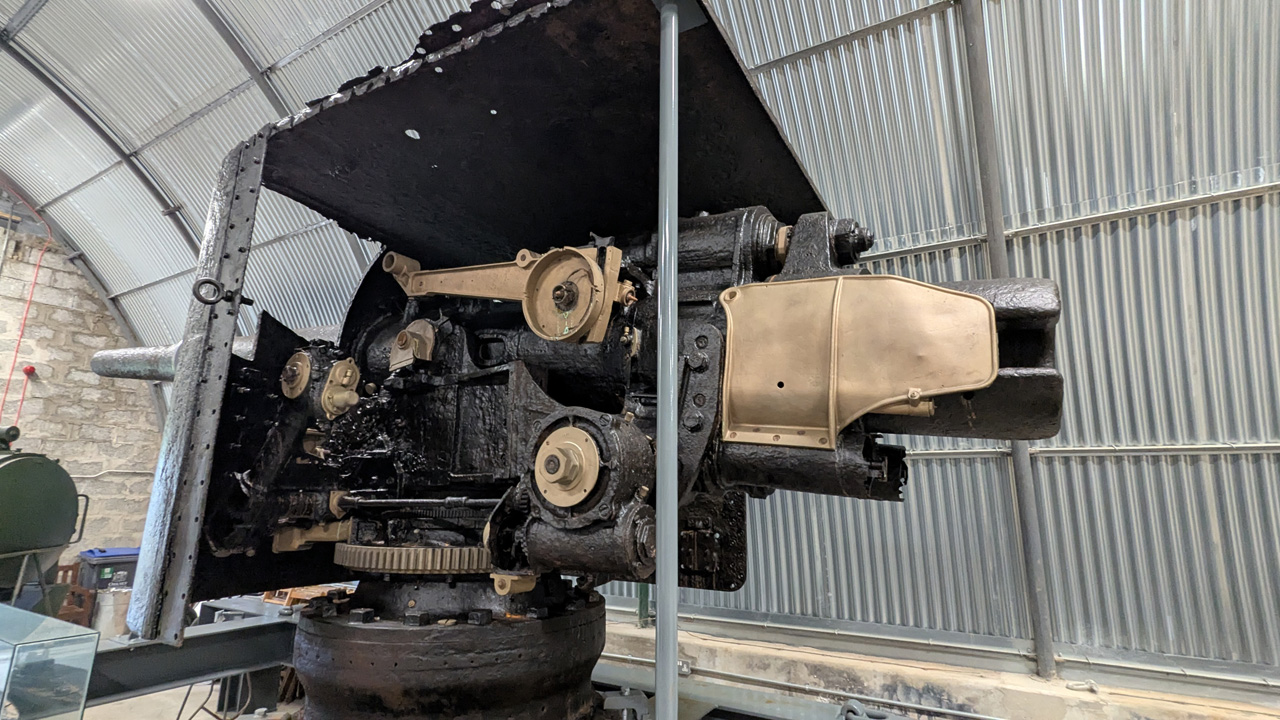
a 5.9" gun from one of the wrecks
Much of the museum consists of the pumping works that once provided fuel oil to the Fleet and if you like looking at big, somewhat steampunk machinery, it's a pleasure.

Pumping equipment
A very good diagram explains how all the bits worked to deliver the huge amounts of fuel these ships needed.

Most of us outside the museum, with HMS Hampshire's propellor - L to R Martyn, Saby, Mike, Andy, Me, David, Izzy, Gill and Caroline. Eddie was on the phone.
Dive 6: SMS Karlsruhe
It was decided that we'd dive the Karlsruhe again in the afternoon and most of the group was quite happy about the choice of the shallower dive, giving those with single tanks longer on the wreck.
Andy and I elected not to take our stages on this dive, as we felt we'd explored the wreck extensively the previous day. I didn't even take my camera.
We were dropped onto the stern this time (some of the others hadn't reached it the previous day) and then made our way along the wreck, spotting numerous things we'd seen before and also entering a hole we'd not seen before which led us through a boiler room and them up and out on the the port side of the hull.
Off to one side of the wreck, we found a near complete toilet bowl resting on the seabed - Others spotted a porcelain bath within the wreck, so it seemed the toilet had been recently removed deliberately.
We dropped down the other side and swam around the knife-edge bow before returning to the forward shotline to ascend.
I had one minute of deco (no ADP this dive), but this cleared just as I reached 6M, so I only had to complete a 3 minute safety stop, although I waited for Andy who still had 1 minute compulsory deco to carry out.
Dive 7: V83 Torpedo Boat
As we'd missed a day's diving due to our delayed arrival and the weather in Scapa Flow, Bob agreed to try and get us some extra dives where possible.
As it turned out, we only did one extra one, but it meant that, even with the lost day, we still did 11 of our planned 12 dives.
On the Wednesday, we were offered a third dive.
This was a shallow dive on a very broken up wreck, the V83, a German vessel that was scuttled with the rest of the fleet and left to fall apart in the shallow water it sank in.
Due to being so shallow, it has nearly all broken up and is very scattered, but there was lot to see amongst the kelp, lots of fish and other sealife, combined with good light even in the late afternoon.
A video from the dive on the V83
We found part of the rear of the ship, looking a bit like a birdcage, still accessible and later came across a boiler.
After the dive, Andy told me there had been a Seal directly below us when we descended, but I'd completely missed it!
Most evenings we found ourselves in the very convivial Ferry Inn, just across the Ferry car park from where Clasina moored each night.

A great selection of local beers in the Ferry Inn
As well as a pleasant atmosphere, they offered an excellent variety of Orkney brewed beers, especially those from the Orkney Brewery and Swannay Brewery, the Dark Island and Duke slipping down especially smoothly, although the Scapa Special and the low alcohol, Lumi were also excellent.
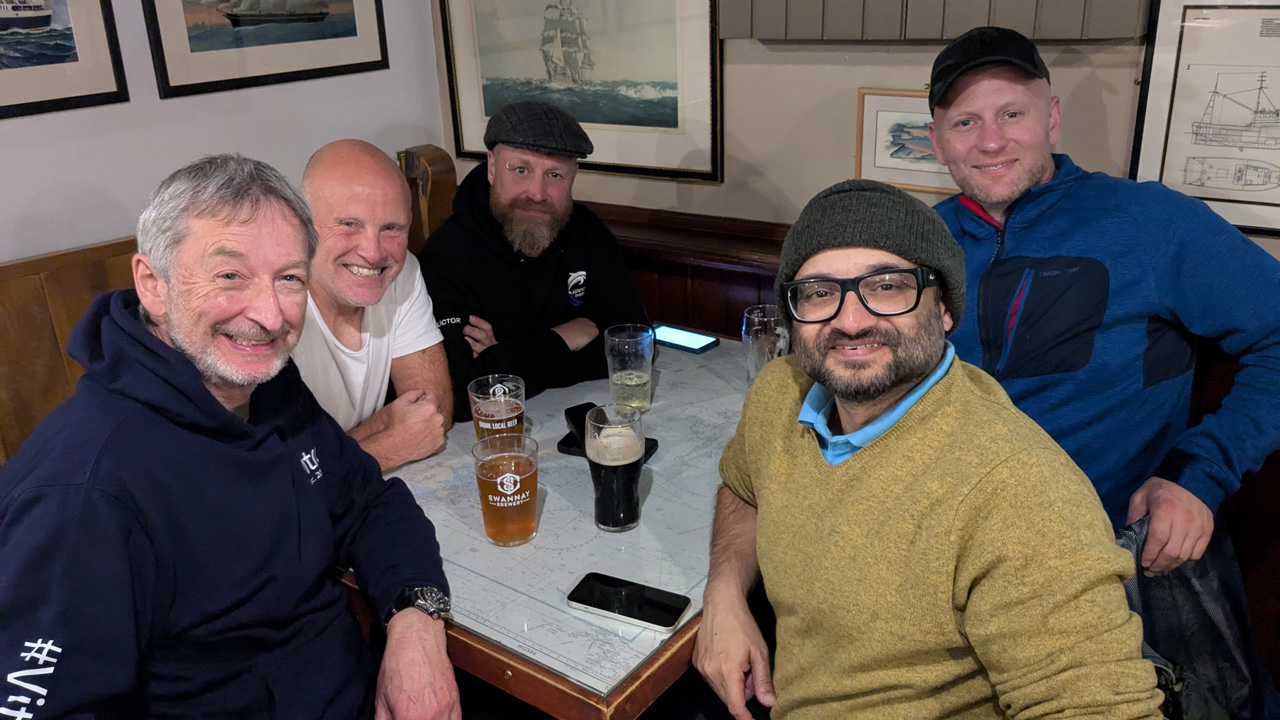
Me, Eddie, Andy, Saby and Martyn (L to R) enjoy another beer in the Ferry Inn
Dive 8: SMS Koenig
The Battleship dive of the trip.
Caroline hadn't wanted to dive a Battleship really, but agreed to as I was so keen to do at least one.
The idea was that the majority of the party, who were on limited gas and not doing ADP, would want to stay on the top of the hull (which is the keel as all the battleships sank upside down) to achieve a decent dive time.
Andy and I followed the shot down to the remains of one of the turbines and then turned right and headed down the outside of the hull to the seabed at 41M.
We didn't stay long there as, as we feared, there was nothing to see as the superstructure and guns have sunk into the relatively soft seabed.
We returned to more or less the same spot on the keel and quickly found the remains of the turbine.
From there we swam around and in the broken wreckage of the salvaged engine room area.
The vis was around 5M (sometimes a bit less) and it was hard to know exactly where we were.
I found a small room accessible through a hole in the keel and saw some pipes, looking a bit like a condensing setup, although I'm not entirely sure what it was and I've not yet found any reference to this in any of the books or websites.
Video from the dive on the Koenig battleship
When I came out I could no longer see Andy's lights, but swam in the direction I had last seen him.
Fortunately, I soon spotted his lights again and we met up. He wasn't sure where the shotline was, but I thought I knew the way, so led until I spotted a square metal frame, which I'd remembered from near the start of our time on the keel.
We quickly found the broken turbine and the shotline nearby, but although we had only 3 minutes of deco at that point, Andy indicated we should ascend, so we started to, but it quickly became clear that he was struggling with a flooded mask.
When we reached the deepest point to switch to our 50% deco gas, Andy couldn't get his computer to do so, so we ascended up to 6M to do the stop, by which point he was able to switch and we completed around 9 minutes of deco and safety stops before returning to the surface and back on the boat.
I was asked to jump back in to recover the buoy the crew had attached to the permanent mooring line, which took me a while as I struggled to unscrew the caribiner below the surface.
We only saw a very limited amount of the ship and I would have happily returned to dive it again, but it wasn't as feature rich as the cruisers, especially for those on single cylinders.
Dive 9: UB116
Saby, one of the club members, was very interested in the story of the UB116, so we dived that on Thursday afternoon.
In the final days of WW1, this submarine was sent in with the intent of causing as much damage as possible to the British Fleet in the hopes of securing better terms for a German surrender, but was sunk very quickly before causing any damage, with the loss of all the crew.
It sank more or less intact, but while being made safe in 1975 a torpedo exploded, damaging the Royal Navy salvage vessel and breaking the wreck up significantly.
We descended onto the wreck and found significant current, which swept us to the stern half of the submarine.
It is very broken up but parts of the hull and at least one of the ballast tanks were clearly identifiable.
The UB116 dive
We worked our back to the bow half, seeing part of the conning tower, and then as we were returning to the shot, spotted a line which we had been told led to the rest of the tower. We followed it and found a couple of small parts of the conning tower, then returned to the wreck and spotted a line ascending.
We followed this, but found that it was an offshoot of the main shotline, which we rejoined, carried out our deco stop on 50% gas and then surfaced.
Martyn and Eddie (diving on a 15L cylinder) had a 15 minute deco stop, coming up after us with no dedicated deco gas, but they managed it with no ill-effects.
Dive 10: Coln
This was mostly a lovely dive, exploring the cruiser, which we now had a good grasp of the layout of.
We descended onto the davits and then swam forward, passing the control tower and then swimming through a significant section inside before exiting at the bow and then swimming up to see that, like the Dresden, it still has the remains of its shield plaque in place.
Video from the Coln dive
As we swam across the bow, I spotted a break, so we dropped down into it and swam a considerable distance along this.
We came to a point where we had to wriggle through and I thought Andy might not follow, but he did, so we continued and I spotted an exit into green water on the left.
Shortly afterwards we reached a dead end, so I turned and indicated to Andy to do so,too, but as we swam back, the corridor filled with falling rust and other mess and almost instantly visibility went to zero, even our lights became invisible in total blackness much of the time.
Swimming, what we though was forward led us into walls and for a few minutes it began to look very serious as we had no visibility and, by this time, no clear idea of the way out.
Things go awry inside the Coln - Those prone to claustrophobia might want to give this video a miss.
Somehow Andy found a way through and, I'm still unclear how as I couldn't see him, I went the same way (perhaps I could sense the movement of his fins in the water). Gradually, and to my huge relief, as we moved forward the visibility went from black, zero to orange, orange but I could see Andy ahead and then the green water of the exit I'd seen on the way in, appeared on our right.
EDIT : Looking at the video, you can see we drop 'down' where we wriggled through and I think we simply swam into the 'wall' below that point and in zero vis couldn't see the entry above us, but Andy must have risen up and found it.
We exited and swam up to the deck and back along to the Davit and the shot, with 'only' 5 minutes deco penalty, suggesting that our time in the zero-vis, dead-end, had been shorter than it felt (Although it was around 9 minutes as the unedited video showed)
We carried on up the shot, completed our deco and exited without further event, but we were both very aware that we'd (mostly I'd, as I was leading) pushed our luck and only a bit of luck on our side and (mostly) keeping our heads had meant we made it safely back on board.
I wouldn't say we laughed about it afterwards, it was a salutory example (happily without a tragic ending) of how over-confidence can quickly turn an enjoyable, exciting dive into a potential disaster.
Dive 11: F2 and YC21 barge again
The sea had been pretty rough for our morning dive and it was decided to dive the F2 again, in sheltered, shallow water, rather than returning to the Dresden, which had been the original plan.
Sea conditions were fairly choppy on the last two days.
After our somewhat stressful experience inside the Coln, Andy and I elected to leave our stages (now fairly empty) behind for this dive and have a relaxed one to round out the week.
Andy and many of the others were flying the next day, too, so the shallow dive suited their nitrogen loading requirements.
Andy and I dropped in with Martyn and Eddie to the F2.
We swam around it a bit, mostly looking for sea life this time, both spotting the Ling that Gill and I'd seen on our first visit.
We then followed the rope to the barge, where we arrived at the same time as Saby, Caroline and David, who'd been dropped directly onto it.
We got some clearer footage of the AA gun in the barge, but the vis overall wasn't as good as on the earlier dive.
Our final dive, back on the F2 and YC21 barge
We then swam around inside the barge a little and then along the undersides looking for Congers, but didn't see any.
We then swam back to the F2, around the bow (I looked up through the hawser to see Andy looking down), back across the deck and then had a little peak inside to test our nerve for a return, without any real problems.
We then decided we'd seen enough, were getting cold after 11 dives in a week in not particularly kind weather conditions, although the dives themselves had had decent vis and the turmoil top side was soon forgotten once you were down a couple of metres.
We had a simple 3 minute safety stop and then surfaced, with a quite lengthy wait in some good sized waves, before reboarding the boat.
Homeward Bound
That evening we all ate an excellent meal in the ever reliable Ferry Inn after dismantling our dive kit.
Although David and Gill hadn't been able to bring their van to Stromness, they realised it was easy to transfer kit from the ferry to their car on return to the Scottish mainland, so kindly took a lot of people's kit home, including my wing, backplate, regs and drysuit, which, if nothing else, made carrying my second bag much easier. I also hoped I'd manage to get it in as my cabin bag on BA and save a £75 charge.
The next morning we said our goodbyes to the crew, Bob and Godders (Ben had departed the previous day, after our return) and most of us ended up catching the bus back to Kirkwall. Andy, Saby and Martyn jumped straight onto another bus, bound for the airport and I walked around to the Kirkwall hotel.
I wasn't flying until the following day (for reasons I forget now, maybe it was cheaper, and I thought another day de-gassing wasn't a bad idea), so had booked a night at The Shore, operated by the Kirkwall Hotel.
The very helpful lady on reception allowed me to leave my bags and directed me to the rather nice first floor lounge, where I spent a few hours updating my dive logs, checking emails and reading, until my room was ready and she took me a couple of doors down to The Shore.
My room was lovely; bright, modern, clean and with a lovely big bed after the week in the cramped bunk in a cabin with next to no storage.
The drizzle declined and I took a stroll around Kirkwall, revisiting the Cathedral and seeing the Royal Oak memorial.
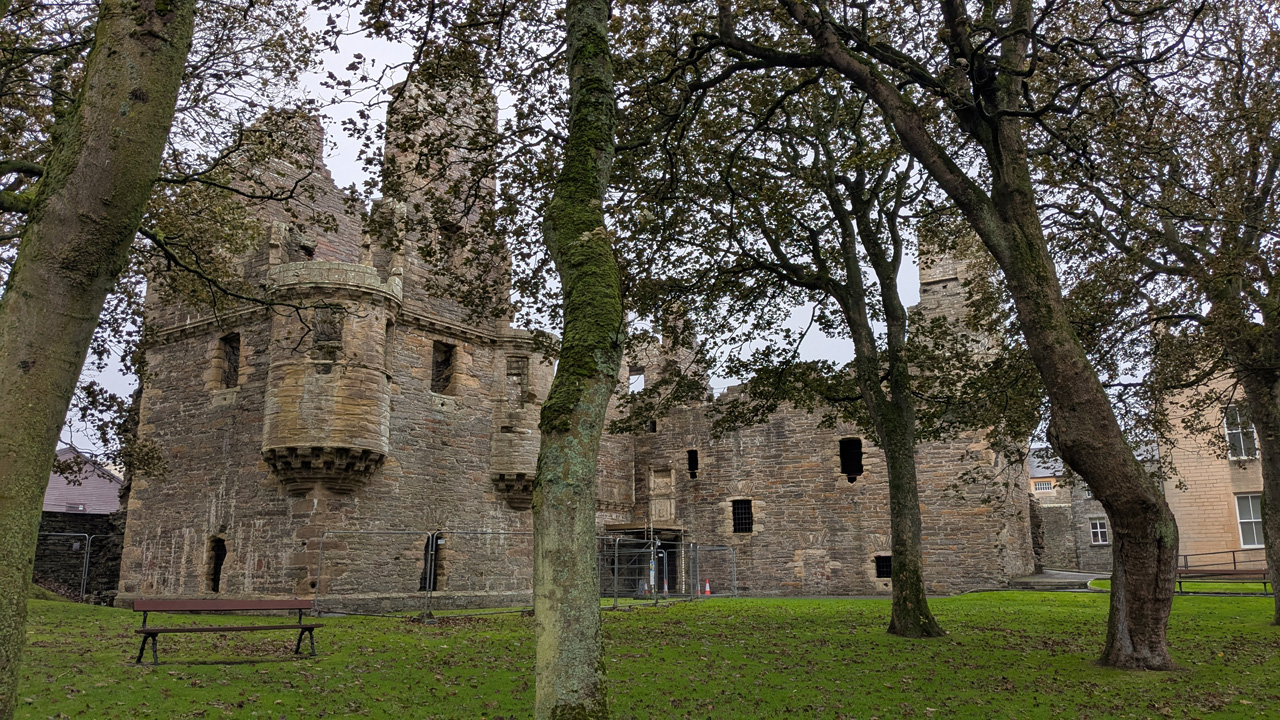
Bishop's House ruins
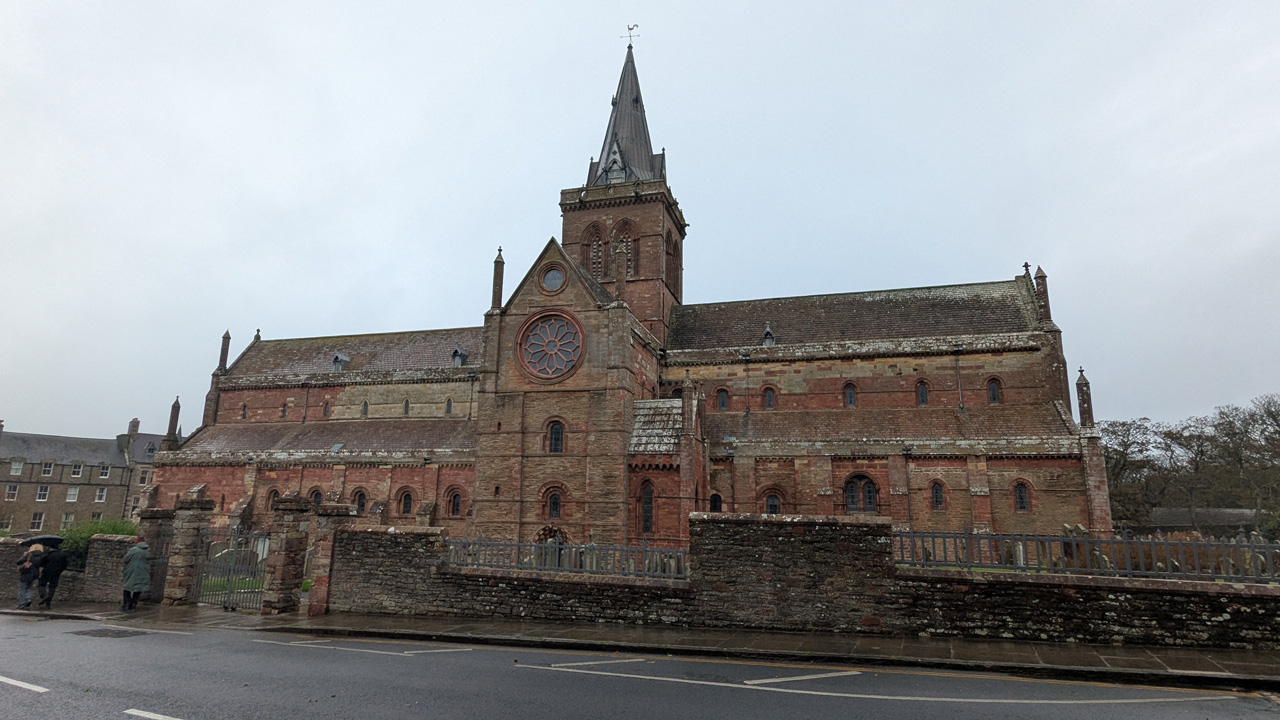
Kirkwall Cathedral
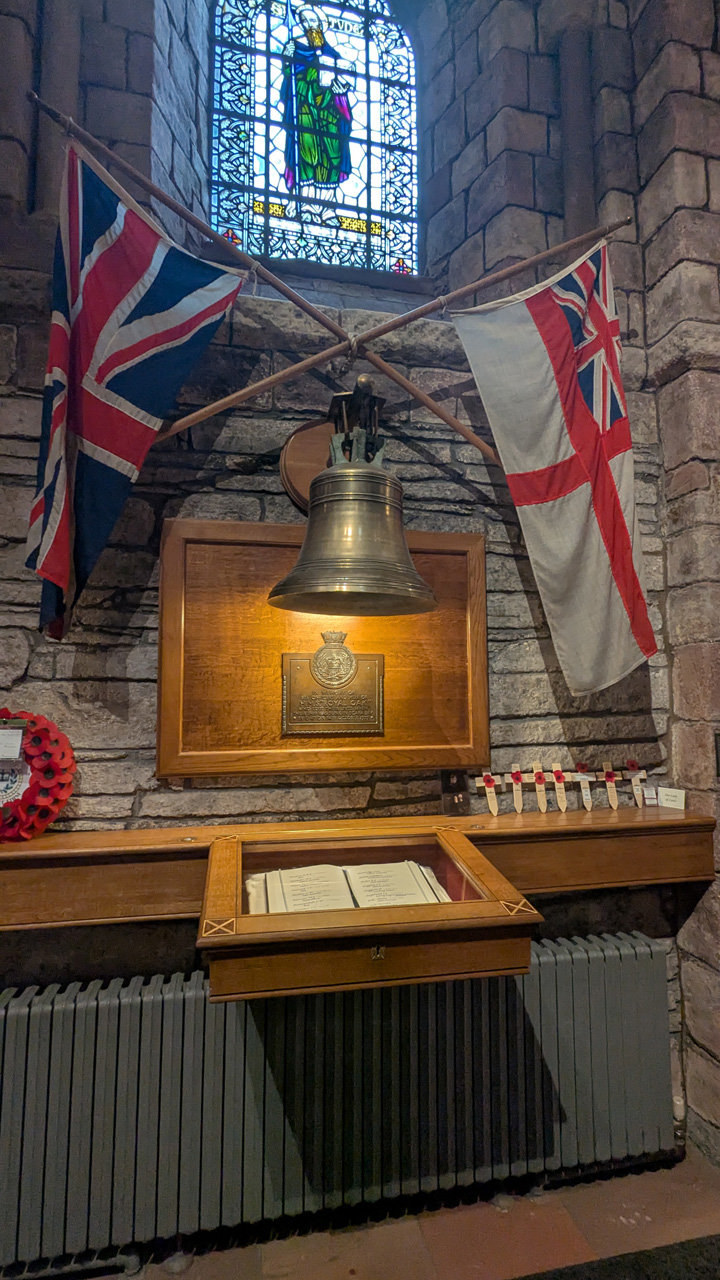
The Royal Oak Memorial

The Cathedral is quite old and more attractive inside than you might expect.
I spotted the Kirkwall Brewery shop and popped in to look at the full range of beers they offered and, chatting to the friendly man in the shop, ended up having a couple of tasters myself, including a 8.5% beercalled "Skull Splitter" - like all their beers it slipped down decepitvely easily!

The excellent range of Orkney Brewery beers - Over the week, I tried about a third of them!
That evening, I had an excellent curry in the Dil Se restaurant, but I can't help thinking I was overcharged as they seemingly deliberately didn't list a price for popadoms and chutneys on my bill and I'm sure I paid more than the menu stated, which was a shame as the Garlic Chilli Chicken was excellent.
My flight was at around 1PM and the trip back to Glasgow ran smoothly. I even managed to avoid paying for a second bag on BA by getting my second bag checked all the way through to Heathrow.

Logan Air flight at Glasgow - It was fine until then!
At Glasgow airport things seemed to be going smoothly, too, and I was hopeful of being home by 6:00PM, but then we were told there was a 'strange smell' at the back of the plane. After some time, we all had to get off and return to the gate.
We hung around there for 3 hours, the smell following us, but never being identified!
Eventually we got back on the plane, only to be told we'd missed a 'slot' and would have to wait another 90 minutes!
That came down to 30 and we were finally on our way back to Heathrow.
Luckily, my bags were some of the first off the plane and I met Mandy at the short stay car park and finally made my way home.
Summary
In general, I'd really enjoyed my time diving back in Scapa Flow.
As I'd hoped, having twin 12L cylinders and the ability to reduce deco time with ADP allowed us to really explore the wrecks to a degree that wasn't possible on my first visit, much as I'd enjoyed that.

Andy and I ready ourselves for another dive.
We did have a very scary few minutes on the Coln, really due to over-confidence, but it turned out OK in the end and I learnt a lesson as a result.
The boat was great to dive from, but certainly on the basic end for accommodation, but after a couple of days it almost became part of the charm and we got the hang of the doors without trapping fingers!
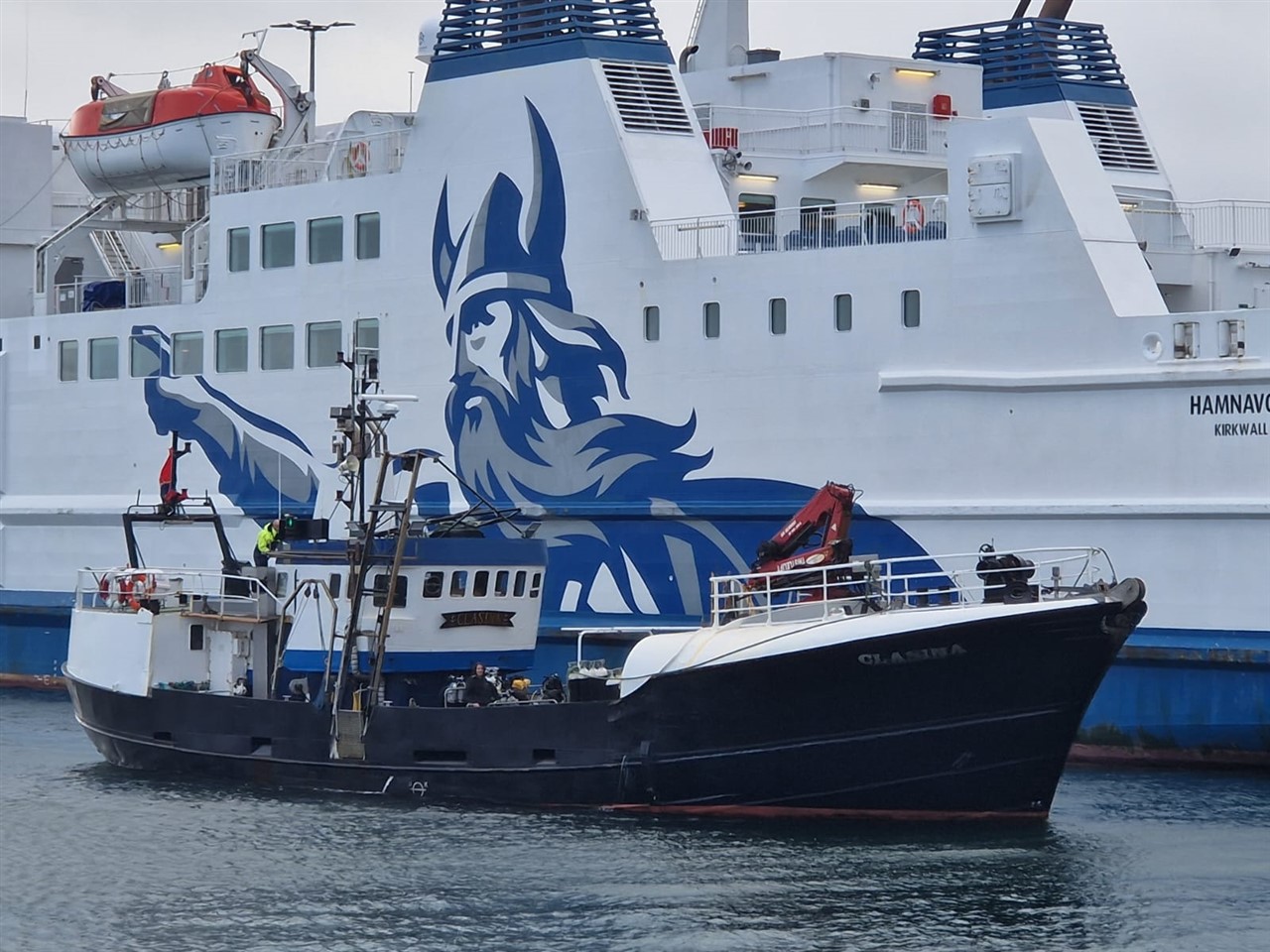
Clasina is a very stable diving platform
That said, I really appreciated my private shower and double bed at The Shore.
Realistically, I doubt I'll ever return to Scapa Flow, there are simply too many other places I want to dive and I'm not getting any younger, but I was definitely very glad I had come back on this occasion and done the diving I'd promised myself I would after my first visit.


